
|   |

|   |
Jugalbandi Dance Festival - Shveta Arora e-mail: shwetananoop@gmail.com Pics: Anoop Arora December 23, 2015 India International Centre and art consultant Usha RK presented Jugalbandi Dance Festival at IIC, New Delhi, on the 19th and 20th of November 2015. 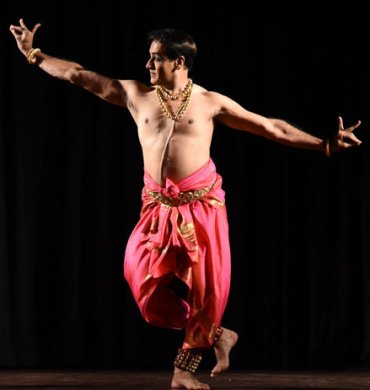 Sathyanarayana Raju  Ajay Kumar On the first evening, it was a jugalbandi between Bharatanatyam dancer Sathyanarayana Raju and Kuchipudi dancer Ajay Kumar. Sathya is the disciple of Late Guru Narmada. Ajay Kumar trained by Guru Kala Krishna and Guru Vedantam Sathyanarayana Sarma specializes in stree vesham. Jugalbandi is also about the rapport between the two dance styles and the two dancers. Abhinaya in Bharatanatyam is subtle, whereas in Kuchipudi, it is dramatic. The two differ in technicalities as well. That evening, the dancers presented Bhama Kalapam from Andhra which expresses the pining of Satyabhama, wife of Krishna, for her beloved. The role of Krishna was essayed by Sathya and that of Satyabhama by Ajay. Ajay’s aharyam, jewellery, makeup, gait, mannerisms, expressions and nuances were every bit feminine. If you didn’t know that it was a man performing, you would never have guessed. Especially the nose ring between the nostrils (besar) gave a very feminine touch to his expressions. Pravesa Daruvu of Bhama Kalapam is a self-introductory piece by Satyabhama herself. “Bhamane, Satyabhamane” where she introduces herself as the daughter of King Satrajit and the most beautiful and desirable wife of Lord Krishna, was executed by Ajay with a lot of flair. Ajay next presented Lekha, where Satyabhama writes a letter to Krishna. Hearing a flute, she is struck by pangs of separation from him. He is the nandanandan, venudhari, with feet like lotuses. Kamadeva is aiming his kusumvana (flower arrows) at her and her misery is enhanced by the cooing of the birds. She asks Madhavi to deliver the letter to Krishna. Ajay’s footwork and expressions were impressive. 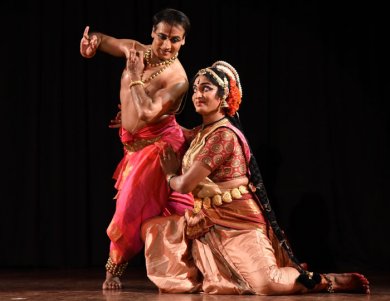 Sathyanarayana Raju & Ajay Kumar
Clad in a red dhoti costume, Sathya enacting the role of Lord Krishna entered with a pravesa daruvu “Rajeevaakshudu Rajagopaludu.” His exactitude of footwork and hastas is always appreciable. Lord Krishna wears the kasturi tilakam, ‘neela megha shyam’ - the blue of the clouds - and his looks shame millions of Kamadevas. Through abhinaya, Sathya related the story of lifting the Govardhan by Krishna on his little finger to save the lives of animals and gopis from the fury of Indra. Krishna steals the clothes of gopis while they are bathing and asks them to beg for them with their hands raised. The abhinaya for this particular portion, enacting both the shy gopis and arm-twisting by the Lord, was remarkable. What followed was a samvada or conversation between the two lovers. Bhama does not receive any reply to her letter, and she is annoyed and upset. As she removes her ornaments, she accuses him of being with the cows, the Kaliya naag and with his other wives too. When Krishna finally appears, the annoyed Bhama runs into the interior of her apartment and covers her face with her sari. When Krishna comes, she looks at him through the corners of her eyes. Ajay was strikingly feminine as the woman expecting the hero to come to her, but is too annoyed to look at him. And as Satyabhama accuses Krishna of being with other women with pangs of jealousy, Sathya as Krishna, stands in the background, as if enacting her thoughts out. But this quarrel ends with the philosophy of advaita, where Satyabhama is the jeevatma for her Lord Krishna, or paramatma. The performance ended with a thillana in raag Vrindavani, a composition of Dr. Balamuralikrishna. Ajay’s mother Sathyawati is the artiste behind his striking stree vesham looks. About the dancer playing the female role being taller than him, Sathya said, “In the texts, it is written that Satyabhama was a tall maid and Krishna was short, and that’s how we were today.” The music ensemble consisted of Srinivas (nattuvangam for Kuchipudi) and Shakuntala Prabhat (nattuvangam for Bharatanatyam), Srivatsa (vocals for Bharatanatyam), Sudha Rani (vocals for Kuchipudi), G. Gurumurthy (mridangam), Rajat Prasanna (flute), and Meeta Mishra on the lights. 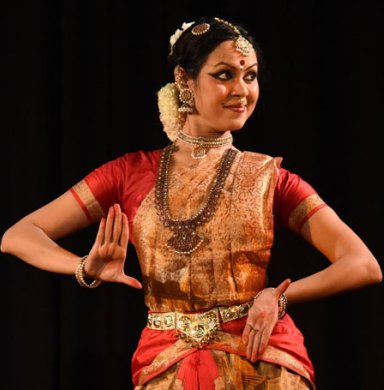 Arupa Lahiri 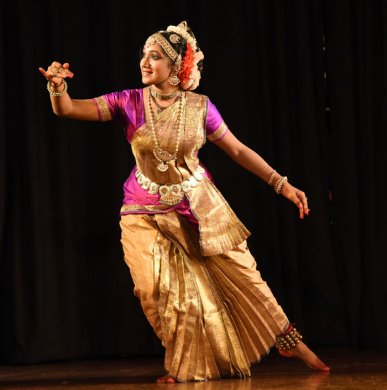 T. Reddy Lakshmi On the second evening, the jugalbandi and samvad was an interesting one. All the time, you hear of compositions about how Hari and Hara - Vishnu and Shiva - complement and worship each other. There is always a comparison, but a complementary one. But here, Parvati and Lakshmi, the consorts of Shiva and Vishnu, give a twist to this vying. The roles of Parvati and Lakshmi were essayed by Arupa Lahiri in Bharatanatyam and T. Reddy Lakshmi in Kuchipudi. Arupa is a disciple of Chitra Visweswaran and T. Reddy Lakshmi is a disciple of Jayarama and Vanashree Rao. 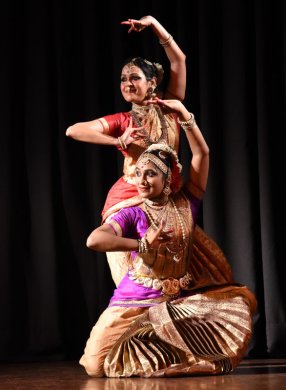 Arupa Lahiri & Reddy Lakshmi
The performance began with a pushpanjali. This was followed by a kautuvam composed in khanda nadai by Arupa Lahiri and Dr. Vasudevan Iyengar. With graceful abhinaya, Arupa as Parvati explored a traditional padam - an unmarried Parvati dreams of her lord. She sees Shiva walking in a procession with matted hair, with the Ganga and the half moon on his head, but she also reminisces about the story of her previous incarnation as Sati, and how she had immolated herself in the yagya of King Daksha. Then she goes on to describe to her sakhis how she has been waiting for him for all these years, wondering if he will accept her now. Lakshmi was at her best as she performed a Thyagaraja krithi, describing the swayamvar of Rama and Sita. King Janaka watches as his little daughter lifts the Shiv Dhanush. Lakshmi depicted Sita tying the toran, making a rangoli - ‘dharani sukumari janakarajanandini tribhuvan sundari’. The little Sita is playing with a ball which falls behind Shiva’s bow. Sita moves the bow with ease and picks her ball up. A stunned Janaka pledges that he will give his daughter in marriage only to someone who can break the Shiv Dhanush. He is surprised and in awe. The kings fail to lift the Shiv Dhanush when they come for the swayamvar. And then “Shri Raghav Raghukul Ratnadeep Rama” lifting the bow and breaking it. In Rama-Sita kalyanam, the knot is tied and the bride and the groom circumvent the sacred fire. Finally, Hari and Hara have their wives turning green with envy. In the devaranama by saint poet Purandaradasa, goddesses Parvati and Lakshmi argue with each other about the superiority of their respective husbands. Parvati, criticizing the dashavataram of Lord Vishnu, makes fun of him being a fish and a turtle, which live in water. Lakshmi counteracts by saying that Shiva lives in the funeral grounds. Vishnu as a boar lives in the muck, whereas Shiva applies ashes on his body. Vishnu is dark-skinned, and Shiva has matted locks. Vishnu is man-lion and a dwarf. Shiva has trinetra (three eyes). Vishnu is helped by monkeys in the Ramavatar, whereas Shiva is accompanied by bhoot-preta and snakes. Vishnu reclines on the snake. The Kalki avatar rides on the horse, whereas Shiva has a bull as his vehicle. The humourous argument draws to a close when Lakshmi and Parvati both realize that Hari and Hara are the same. Arupa and Lakshmi did justice to the piece. Their abhinaya, postures and jestful expressions were immaculate. The final thillana in Revathi raga was a composition of Maharajapuram Santhanam. It praises the devi as matangi, mahishasuramadini, mookambika, parashakti. The agility of the two young dancers was evident. The ensemble consisted of Jayarama Rao (nattuvangam for Kuchipudi), Shakuntala Prabhat (nattuvangam for Bharatanatyam), Satish Venkatesh (vocals), Keshavan (mridangam), Rajat Prasanna (flute), with Meeta and Govind on the lights. Shveta Arora is a blogger based in Delhi. She writes about cultural events in the capital. |